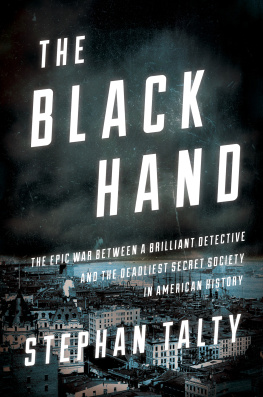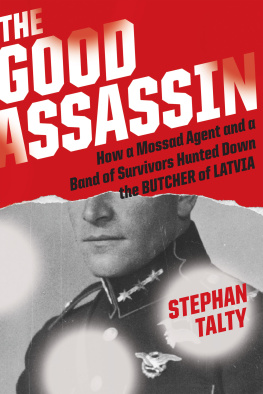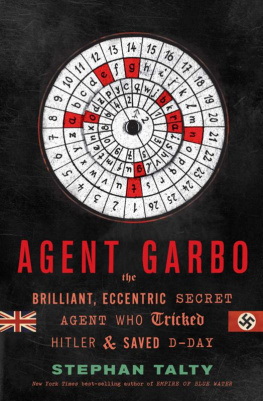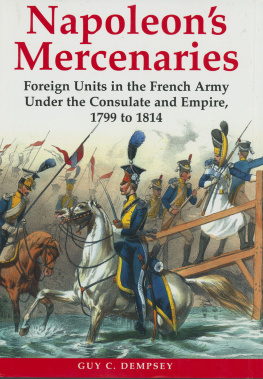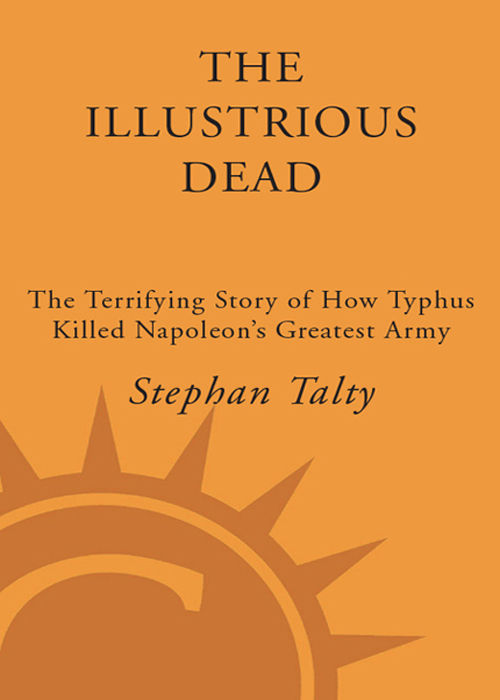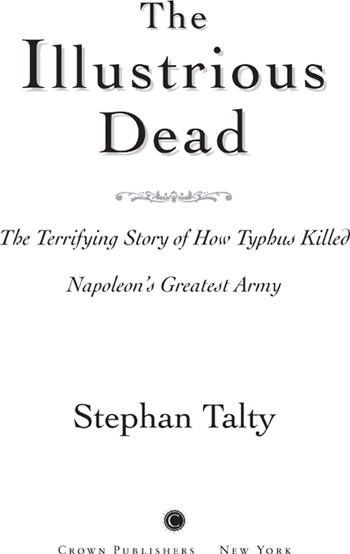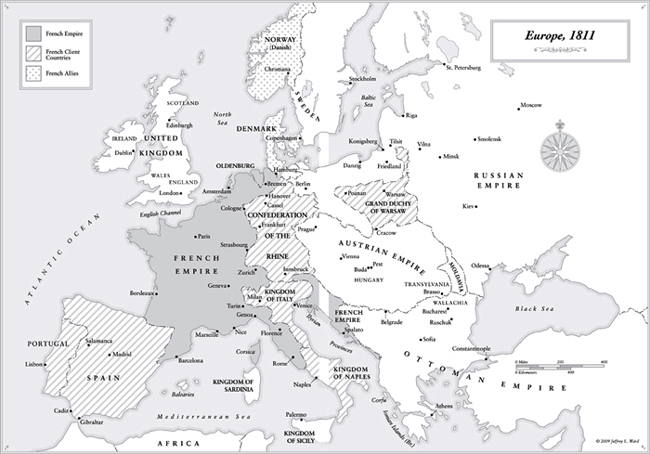The Grande Arme
Command Structure
N APOLEON
B ERTHIER
Chief of staff
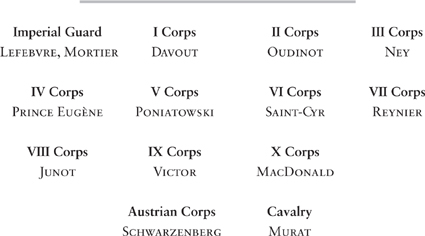
The Russian Army
Command Structure
T SAR A LEXANDER I
(Political head of Russia)
G ENERAL M IKHAIL B ARCLAY DE T OLLY
(Minister of War, acting head of army until August 20)
F IELD M ARSHAL P RINCE M IKHAIL I LARIONOVICH K UTUZOV
(Commander in chief, appointed August 20)
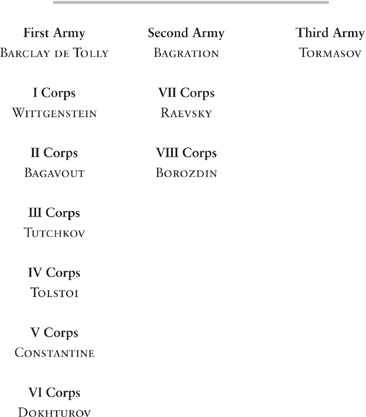
Coalitions Against France During the Napoleonic Era
First Coalition (179297)
A USTRIA , P RUSSIA , G REAT B RITAIN , S PAIN, AND THE P IEDMONT
Napoleon emerges from obscurity to conquer Italy. France gains Belgium, the Rhineland, a partitioned Venice, and most of Italy.
Second Coalition (1798-1801)
R USSIA , G REAT B RITAIN , AUSTRIA, THE O TTOMAN E MPIRE , P ORTUGAL , N APLES, AND THE V ATICAN
Napoleon returns from Egypt to defeat the Austrians at the Battle of Marengo, France gains control of the Netherlands, and Austria accepts French domain over Italy and territories as far north as the Rhine.
Third Coalition (1805)
A USTRIA , G REAT B RITAIN , R USSIA, AND S WEDEN
England smashes the French and Spanish fleets at Trafalgar and rules unchallenged over the waters. Napoleon triumphs at Austerlitz against Austria and Russia. The German states are organized into the Confederation of the Rhine as a redoubt around France.
Fourth Coalition (18067)
P RUSSIA , G REAT B RITAIN , S WEDEN , S AXONY, AND R USSIA
Napoleon crushes Prussia at the Battles of Jena and Auerstedt. The French fight the Russians to a draw at Eylau. France occupies Prussia, including Berlin. The Treaty of Tilsit gives France half of Prussias land as well as the Kingdom of Westphalia. The Grand Duchy of Warsaw, which includes most of modern-day Poland, is created.
Fifth Coalition (1809)
G REAT B RITAIN AND A USTRIA
Napoleon triumphs at the Battle of Wagram. Austria loses Carniola, Carinthia, and the Adriatic ports to France; Galicia to Poland; and Tyrol to Bavaria.
Sixth Coalition (1813-14)
G REAT B RITAIN AND R USSIA, JOINED BY P RUSSIA , S WEDEN , A USTRIA, AND THE G ERMAN S TATES
France is driven out of Germany and the nation is occupied. Napoleon is exiled to Elba.
Seventh Coalition (1815)
G REAT B RITAIN , R USSIA , P RUSSIA , S WEDEN , A USTRIA, AND THE G ERMAN S TATES
Napoleon returns from exile but is defeated at Waterloo and is exiled to St. Helena, where he dies in 1821.
Introduction: Old Bones
I N LITHUANIA, LATE IN THE WINTER OF 2001, CONSTRUCTION crews began clearing a piece of land in that part of the capital, Vilnius, known as Northern Town, digging trenches for phone lines and demolishing the old Soviet barracks that had stood on the land for decades. Vilnius was booming, with new money flooding in and decades of oppression under Moscow and Berlin seeming at last ready to vanish along with the last physical traces of imperialism. Real estate developers had snapped up the old troops quarters to be made into luxe new homes for the computer programmers and regional managers who would soon turn this forbidding collection of buildings into a sparkling hub of the new Europe.
The work had gone smoothly until one bulldozer scraped up a layer of soil and uncovered something white underneath its blade. The operator looked down and saw bones, bones that were quite clearly human: femurs, ribs, skulls. One worker later told a reporter that the white things wouldnt stop coming out of the ground. There were thousands of them.
Word spread to nearby neighborhoods, and men and women came hurrying across the fields, their boots crunching in the hoarfrost and their breath blowing white. There had been whispers for years about this place, rumors that the KGB had used the barracks as torture chambers for political dissidents. Many believed that those who hadnt survived the questioning had been buried in mass graves somewhere on the grounds. Eight years earlier, a grave filled with seven hundred KGB victims had been found a few hundred yards away. The local people looked down into the freshly dug hole, looking for missing lovers, sisters, or sons.
Or perhaps these were the corpses of Jews murdered by the Nazis. Hitlers bureaucrats had set up two ghettos in the city after occupying it in June 1941 and then slowly drained them of men, women, and children, eventually killing 95 percent of the countrys Jewish population.
When archaeologists from the University of Vilnius arrived, they saw that the bodies had been stacked three-deep in a V-shaped trench and quickly realized that the men had been buried in the same pits they had dug to defend themselves. Clearly, the men were soldiers, not dissidents or civilians. And they were robust specimens, many of them tall and broad-shouldered, most between fifteen and twenty years old, with a few women mixed inprostitutes was the early guess.
As they excavated the 2,000 skeletons, the archaeologists found a plaque that had once adorned a helmet, decorated by an eagle and a cockade in faded red, blue, and white. There were curious belt buckles inscribed in several languages, buttons with regiment numbers such as 29 and 61. And there were, crucially, 20-franc coins that dated from the early 1800s. The remains were too old to be the victims of either Stalin or Hitler.



